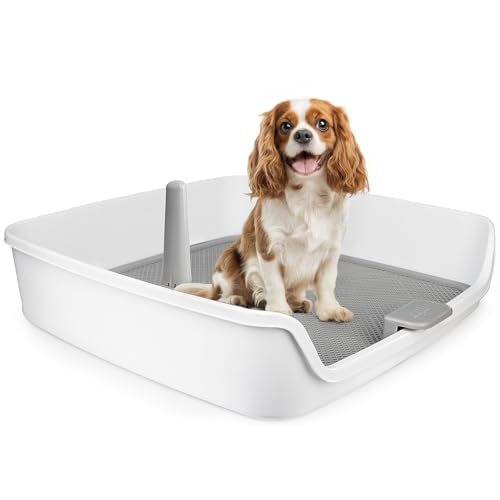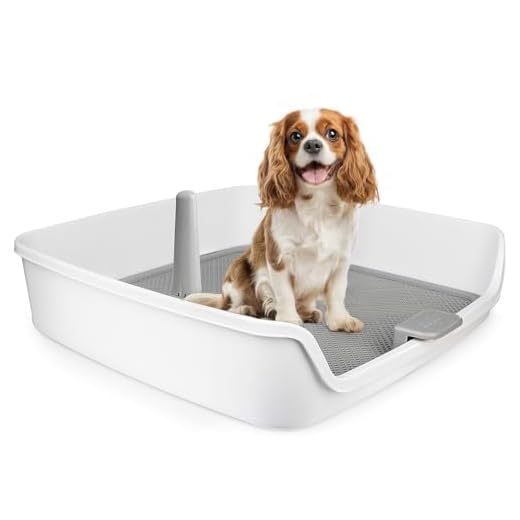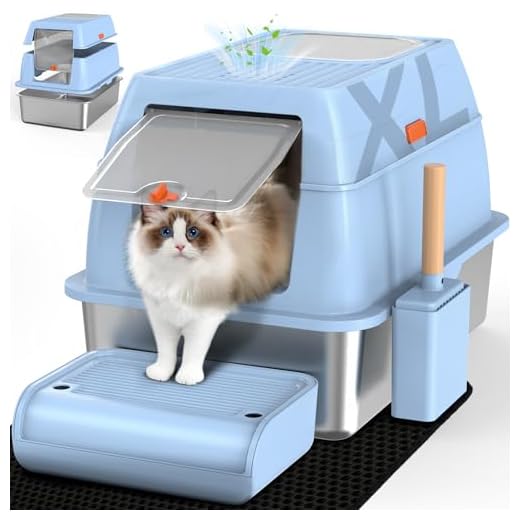




Establishing a routine for a furry friend to relieve themselves indoors is indeed possible. Begin by selecting an appropriate area within the home, ensuring it’s easily accessible and away from high-traffic zones. Consider using a specific mat or pad designed for this purpose; this helps create a designated spot that the pet can associate with bathroom activities.
Consistency plays a pivotal role in this process. Frequent visits to the chosen area after meals and naps will reinforce the behaviour. Positive reinforcement is key–reward with treats or praise immediately after the canine performs as desired. This encourages repetition of the behaviour and strengthens the association between the area and relief.
Patience is crucial; some may adapt quickly while others take longer. Monitor for signs that indicate the need to go, like sniffing or circling. If accidents occur, avoid punishment; instead, clean up thoroughly to eliminate lingering scents that might confuse the pet. Over time, with dedication and a structured approach, achieving success in this endeavour is entirely feasible.
Choosing the Right Litter Box for Your Canine Companion
Opt for an enclosed design if privacy appeals to your furry friend. This can help reduce distractions and make the experience more comfortable. Look for a sturdy construction that can withstand some enthusiastic digging.
Size Matters
Ensure the dimensions are appropriate for the breed. Larger breeds may require a more spacious option, while smaller varieties can manage with a compact version. Measure your pet’s height and length to select a suitable fit, allowing enough room for movement.
Material Considerations
Plastic is a common choice due to its lightweight and easy-to-clean nature. However, consider options with a non-porous surface to prevent odours from lingering. Some boxes feature removable trays, simplifying the cleaning process. Look for materials that resist wear and tear, especially if your pet is an enthusiastic user.
Assess the entrance height as well. Older or less mobile animals may struggle with high walls. A lower entry point can be beneficial, making access easier.
Finally, think about aesthetics. A box that blends with your home decor can enhance your living space while serving its purpose. Choose a design that suits your style and your pet’s needs.
Training Techniques for Litter Box Use
Start with positive reinforcement. Whenever your canine approaches the designated area, reward them with treats and praise. This builds a connection between the location and a positive experience, encouraging repeat visits.
Consistency is key. Establish a routine for bathroom breaks. Take your furry friend to the spot at the same times each day. Over time, they will begin to associate these moments with the task at hand.
Introduce the area gradually. Allow your companion to explore the surroundings without pressure. You might even place their favourite toys nearby to make the space more inviting. This familiarity can make all the difference.
Observe their behaviour. Pay attention to signs that indicate they need to relieve themselves, such as sniffing, circling, or whining. When you notice these cues, guide them to the designated spot immediately.
Limit distractions. Ensure that the area is quiet and free from disturbances during initial attempts. A calm environment helps your pet focus and feel secure while learning.
Be patient. Accidents will happen. Instead of scolding, clean up calmly and redirect them to the correct area. Repetition is part of the learning process, and staying patient will lead to progress.
Consider using a specific type of substrate. Some canines are more receptive to certain textures. Experiment with various options until you find one that suits your pet’s preferences, making the process more appealing.
Gradually reduce the size of the area. Once they become accustomed to the initial space, consider shrinking it to a more manageable size. This can help them develop a clearer understanding of where to go.
Monitor progress closely. Keep track of successes and setbacks. This information can guide adjustments in technique and help identify patterns in behaviour, which can be insightful for future training.
Involve the family. Ensure everyone understands the routine and is on the same page. Consistent reinforcement from all household members solidifies the training process.
Common Challenges and Solutions in Litter Box Training
One frequent issue arises from the choice of substrate. If the material doesn’t feel right to the pooch, it may refuse to engage. Experiment with different types of fillers, such as paper pellets or grass, to find the most appealing option.
Another hurdle is the location of the receptacle. It should be placed in a quiet, accessible area where the pet feels secure. Avoid high-traffic zones or places with loud noises that could create anxiety.
Consistency in routine is key. Establish a schedule for bathroom breaks, and ensure that the space is clean and inviting. If accidents occur, immediately clean the area with an enzymatic cleaner to eliminate lingering odours that might encourage repeat behaviour in the same spot.
Some pups may exhibit reluctance due to stress or anxiety. In such cases, creating a positive association with the area is essential. Use treats or praise whenever the pet approaches or interacts with the designated spot. Patience is crucial; it may take several attempts before the desired behaviour is established.
Monitoring dietary habits can also play a significant role. Adjusting meal times or types of food may influence bathroom habits. Consult a vet if you notice any irregularities, as digestive issues can impact training progress.
Finally, consider the size of the receptacle. It must be spacious enough for the pet to enter comfortably. If it feels cramped or restrictive, it may deter them from wanting to go inside.
Maintaining Hygiene and Managing Odours in the Litter Box
Regular cleaning is key to keeping the space fresh and free from unpleasant smells. Aim to scoop waste daily and change the substrate weekly. This not only helps in controlling odours but also promotes a healthier environment for your pet.
Here are some practical tips for maintaining cleanliness:
- Use odour-absorbing materials: Consider substrates designed to neutralise smells. Products containing baking soda or activated charcoal can be particularly effective.
- Wash the container: Clean the receptacle with mild soap and water weekly. Avoid harsh chemicals, as they can be harmful to pets.
- Consider a covered option: A covered container can help contain smells and prevent messes, but ensure it’s well-ventilated to avoid trapping odours.
- Ventilation is crucial: Place the setup in a well-ventilated area to help disperse any lingering scents. If possible, keep a window open.
In addition to these tips, using air fresheners or odour neutralisers can provide an extra layer of freshness. Just ensure they’re pet-safe. Be cautious with scented products; some pets may be sensitive to strong fragrances.
In my experience, placing the container in a discreet location also helps in managing smells, as it keeps the area out of sight and mind. I found that keeping the space clean not only benefits my furry friend but also enhances the overall comfort of our home.
For those interested in maintaining a balanced diet for their pets, check out who makes gravy train dog food, as nutrition plays a role in digestion and can impact waste quality.
FAQ:
Is it possible to train a dog to use a litter box?
Yes, it is possible to train a dog to use a litter box. Many pet owners have successfully taught their dogs to relieve themselves in a designated area inside the house. This can be particularly useful for smaller breeds or for dogs that may have difficulty going outside due to weather or health issues. The process involves consistency, patience, and positive reinforcement.
What steps should I take to start litter box training my dog?
To begin litter box training your dog, first, choose an appropriate litter box that is the right size for your dog. Place it in a quiet, accessible location. Next, introduce your dog to the box and encourage them to explore it. Use treats and praise when your dog shows interest in the box. Gradually, start taking your dog to the box after meals or naps, as these are common times for them to need to relieve themselves. If your dog uses the box, reward them immediately to reinforce the behaviour.
Can all dog breeds be trained to use a litter box?
While most dogs can be trained to use a litter box, some breeds may adapt more easily than others. Smaller breeds, like Chihuahuas or Dachshunds, are often more suited to litter box training due to their size and indoor habits. Larger breeds may require more space and may be less inclined to use a litter box. However, with consistent training and positive reinforcement, many dogs, regardless of their breed, can learn to use a litter box.
What type of litter is best for training my dog?
When selecting litter for your dog’s litter box, opt for a type that is safe and comfortable for them. Many pet owners prefer using paper-based or wood-based litters, as they are absorbent and easy to clean. Avoid clumping cat litters, as they can be harmful if ingested. It’s important to choose a litter that does not have strong fragrances, as dogs can be sensitive to strong smells. Experiment with different types to see which one your dog prefers.
How long does it typically take to train a dog to use a litter box?
The timeframe for training a dog to use a litter box can vary widely based on the individual dog and the consistency of the training. Some dogs may take just a few days to get the hang of it, while others may need several weeks. Regularly taking your dog to the litter box and rewarding them for using it will help speed up the process. Patience and persistence are key, as each dog learns at their own pace.
Can all dog breeds be trained to use a litter box?
Not all dog breeds may take to litter box training equally. Smaller breeds, such as Chihuahuas and Dachshunds, often adapt better to this method due to their size and indoor nature. Larger breeds might find it more challenging, as they generally require more space. However, with patience and consistent training, many dogs can learn to use a litter box, regardless of breed. It’s important to consider your dog’s personality and preferences when deciding if this training method is suitable.
What steps should I take to train my dog to use a litter box?
Training your dog to use a litter box involves several steps. First, choose an appropriate box that is the right size for your dog and fill it with suitable litter. Next, place the box in a quiet, accessible area where your dog feels comfortable. Begin by encouraging your dog to use the box after meals or when they wake up, as these are common times for elimination. Use positive reinforcement, such as treats and praise, when your dog successfully uses the box. Be patient, as this process may take some time. If your dog has accidents elsewhere, avoid punishment; instead, redirect them to the box. Consistency and encouragement are key to successfully training your dog.








